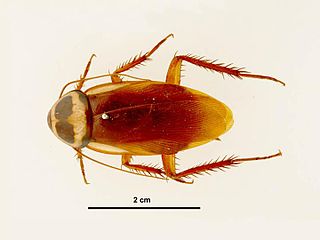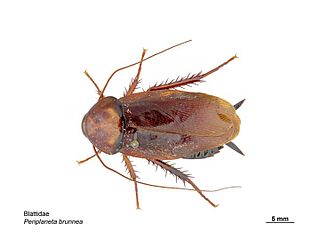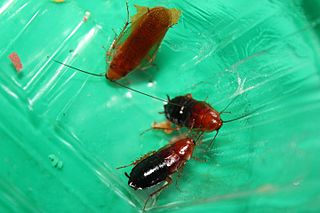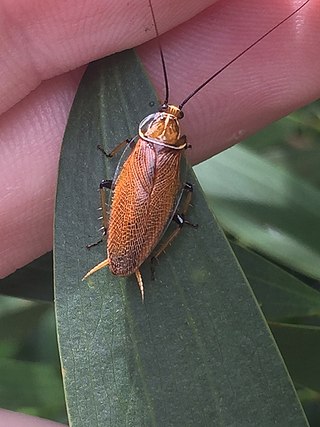
The Florida woods cockroach is a large cockroach species which typically grows to a length of 30–40 mm (1.2–1.6 in). When alarmed, adults can eject an extremely foul-smelling directional spray up to 1 m, which inspired several of its other common names: Florida skunk roach, Florida stinkroach, skunk cockroach, skunk roach, stinking cockroach, and stinkroach. Two other naming variations include Florida cockroach and Florida woods roach.

The Surinam cockroach or greenhouse cockroach is a species of burrowing cockroach. It is a common plant pest endemic to the Indomalayan realm that has spread to tropical and into subtropical regions around the world, and in isolated populations to temperate climates where protective habitat such as greenhouses provide shelter for individuals inadvertently shipped in the soil of plants. Its populations are almost exclusively female, and it reproduces through parthenogenesis, having evolved several clonal strains from its sexual progenitor P. indicus.

The Australian cockroach is a common species of tropical cockroach, with a length of 23–35 mm (0.91–1.38 in). It is brown overall, with the tegmina having a conspicuous lateral pale stripe or margin, and the pronotum with a sharply contrasting pale or yellow margin. It is very similar in appearance to the American cockroach and may be easily mistaken for it. It is, however, slightly smaller than the American cockroach, and has a yellow margin on the thorax and yellow streaks at its sides near the wing base.

The smokybrown cockroach is a large species of cockroach, winged, and growing to a length of 32–35 millimetres (1.3–1.4 in).

The Pennsylvania wood cockroach or Pennsylvanian cockroach is a common species of cockroach in eastern and central North America.

Parcoblatta virginica, the Virginia wood cockroach, is a small cockroach species of the genus Parcoblatta, measuring about a centimeter long as an adult.

Parcoblatta fulvescens, the fulvous wood cockroach, is a species of cockroach endemic to the United States and possibly Canada that measures around 13 mm (0.5 in) long.

The brown cockroach is a species of cockroach in the family Blattidae. It is probably originally native to Africa, but today it has a circumtropical distribution, having been widely introduced. In cooler climates it can only survive indoors, and it is considered a household pest.

Cariblatta lutea is a small species of cockroach native to the United States and other countries, measuring usually around 7 millimeters long as an adult and under 2 millimeters from head tip to abdomen tip at the 1st instar or hatchling. It consists of two subspecies, the small yellow cockroach, and the least yellow cockroach.

Parcoblatta bolliana, Boll's wood cockroach or Boll's wood roach, is a small species of wood cockroach native to the United States, measuring around 11 mm (0.43 in) long.

Parcoblatta uhleriana, the Uhler's wood cockroach, is a species of Parcoblatta native to the United States and Canada. It is a forest species also found in disturbed and urban environments. The male of the species flies freely, while the female does not fly.

Parcoblatta lata, the broad wood cockroach, is a species of wood cockroach native to the United States. It is one of the largest species of wood cockroaches.

Parcoblatta caudelli, Caudell's wood cockroach or Caudell's wood roach, is a species of cockroach native to the United States.
Parcoblatta zebra, the banded wood cockroach, is a species of Parcoblatta native to the United States. It has dark transverse bands across the back of its abdomen.
Parcoblatta desertae, the desert wood cockroach or desert cockroach, is a species of Parcoblatta endemic to the United States state of Texas.

Parcoblatta americana, the western wood cockroach, is a species of wood cockroach that occurs in Mexico and the western United States.
Parcoblatta notha, the Arizona wood cockroach, is a species of wood cockroach that occurs only in the southwestern US state of Arizona. It is a relatively large, light colored member of the 12-species wood cockroach genus Parcoblatta. The male has fully developed wings and is able to fly, while the female wings are around half as long and does not fly.

Morgan Hebard was an American entomologist who specialized in orthoptera, and assembled a collection of over 250,000 specimens.

The Pseudophyllodromiinae are a subfamily of cockroaches, in the family Ectobiidae, with a world-wide distribution.

Balta bicolor is a type of cockroach from the genus Balta. Native to eastern Australia, the species has been identified in New Zealand since 2009.



















